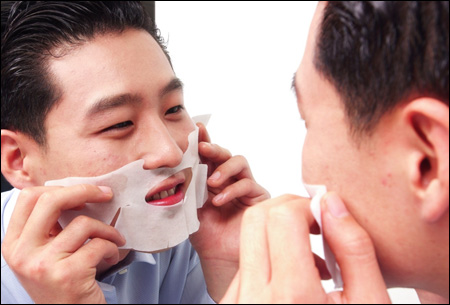Men’s ever-growing grooming needs
 Consumers with deep pockets and cultural shift drive markets
Consumers with deep pockets and cultural shift drive markets
“No shame: get a free eyebrow touch-up and makeup for men”
A blackboard sign said standing in front of a cosmetics shop named Manstudio.
Located at the center of a bustling, hip street of Hongdae in Seoul, it is the first local cosmetics shop specifically for men — exposing dim yellow lighting, sparingly decorated with metalwork and brick walls.
Men’s grooming, which used to have been associated with “unmanliness,” has become one of the fastest growing businesses worldwide, and Korean men have shown an outstanding demand, especially in skincare products.
An estimate size of the men’s grooming industry in Korea reached roughly $696 million in 2011, according to the latest data by Euromonitor International, a consumer market research firm.
The estimated global market size for 2011 was $31 billion, the data said.
“There used to be even no concept of men’s grooming before, … , now it has become an important part of their lives, especially for men in their 20s and 30s to show that they’re taking care of themselves,” said Ok Eun-jae, a spokeswoman for AmorePacific.
And especially skincare takes up more than half of the entire Korean grooming market, a much larger proportion compared to other countries, the report said.
Men’s grooming industry generally comprises shaving kits including razors, blades and shaving creams, and toiletries such as shower, hair and facial products.
And the male nurturing market is predicted to expand further thanks to emerging consumers with deep pockets and more acceptance to Western brands.
“While the metrosexual craze has come and gone, the grooming-conscious male is here to stay,” said the Euromonitor International research note. It also predicted that the underlying segments will diverge starkly.
China’s young, urban and affluent men are a strong force in particular, accounting for 31 percent of value shares globally, according to the memo.
Closely following the Western and Japanese trends, these consumers tend to be career-focused and generally associate well-groomed and fashionable appearance with higher social status.
The foreign brands such as L’Oreal’s Biotherm Homme and ELCA’s Clinique for Men, recorded strong value growth of 20 percent and 60 percent, respectively in 2010, compared to a previous year, the memo said.
And it’s not just the products rising in demand but the attitude toward men’s pampering has shifted.
“Of course, guys should groom themselves, there’s nothing wrong with that,” said Hong Sung-woo, 26, a freelance D.J. With a side-cropped hair and neatly shaped eyebrows, Hong said he regularly gets his hair and eyebrows done at a salon.
Nearly 30 percent of men said they take grooming most seriously in efforts to improve their appearances, according to a survey done by Men’s Health magazine over 2,500 Korean men in 2010. Fashion ranked as a top priority over grooming, followed by exercise and diet.
“As we do this survey every year, we see a distinct change in men’s attitude,” said Ryu Han-woo, a fashion and grooming editor at Men’s Health magazine, in Seoul.
“They have become proactive and vocal about the products, … , they pay attention to details and give specific feedback,” Ryu said.
The change in attitude and soaring interest in grooming encouraged men to come out to offline shops like Manstudio.
About 50 to 60 men regularly visit the store in a week for facial and hair treatments, which cost between 25,000 won and 50,000 won for a 45-minute session, said Kim Mi-hyang, a store manager.
Open in 2010 by AmorePacific, Korea’s largest male grooming brand now runs two more studios, one in Jamsil, Seoul and another in Suwon, Gyeonggi-do.
Besides selling a range of local and foreign brands of skincare and hair products to makeup and perfume, the specialists in the store also provide services such as skin- and scalp testing and treatment.
“We’re investing more on product development and we plan to launch more makeup lines, too, to fill the needs of men,” said Ok with the AmorePacific.
The company has enjoyed roughly 20 percent of sales growth of the for-men studios since they opened, Ok said.
AmorePacific owns 24 percent of value share with an array of skincare brands including Hera Homme, Iope for Men, Odyssey and Miraepa, according to Jena Han, an analyst with HSBC. LG Household & Health Care comes behind with a 15 percent share, with its primary brand O HUI For Men and Whoo Gun.
Procter & Gamble is the undisputable leader with almost 50 percent market share, and Unilever Group, Revlon and L’Oreal are among the top players, Han said.
Choi Hwan-jun, 34, a government employee who works in Gwanghwamun, stopped by at Manstudio for a facial-care appointment.
“As I get older, I feel a need to get those treatments,” Choi said. As a specialist was testing the health of his skin, he said his latest concern is blackheads and pores on his face. “I’ve tried one of those blackhead removers on my nose but it worked only for some time,” he said as he chuckled.
Choi said he found one-on-one skincare consulting with specialists the most helpful.

<Korea Times/Kang Ye-won>




















































is there any sort of organic remedies ?
really does Gynexin Supplements wipe out man breasts ?